NRTI (eg: zidovudine, stavudine, abacavir and didanosine)
- lactic acidosis (mitochondrial dysfunction) and peripheral neuropathy
- abacavir is associated with potentially fatal hypersensitivity reaction (HLAB5701)
- associated with fat metabolism abnormalities (treatment = pravastatin)
NNRTI
- efavirenz: nightmares, hallucination
- nevirapine: liver dysfunction, severe rash with eosinophilia
protease inhibitor (eg: indinavir, ritonavir)
- hyperlipidemia, lipodystrophy
- indinavir crystallises in renal tract causing renal stone
Total Pageviews
Tuesday, 29 November 2011
Sunday, 27 November 2011
Amyloidosis
- disorder of protein metabolism in which there is an extracellular deposition of pathological insoluble fibrillar proteins in organs and tissues
- diagnosis made by biopsy of affected tissue and positive Congo Red staining with red green birefringence under polarised light microscopy. Rectum or subcutaneous fat are relatively non-invasive site for biopsy
Primary amyloidosis (AL amyloidosis)
- in lymphoproliferative disorder (myeloma, MGUS, non-Hodgkin lymphoma), clonal plasma cells in bone marrow produce immunoglobulins that are amyloidogenic
- presents with nephrotic syndrome, cardiomyopathy (avoid digoxin), autonomic and sensory neuropathies, hepatomegaly, periorbital purpura and macroglossia
- echo : 'sparkling' appearance (restrictive cardiomyopathy)
Familial amyloidosis (transthyretin-associated)
- autosomal dominant
- renal disease less prevalent than AL amyloidosis and macroglossia does not occur
Reactive amyloidosis (AA amyloidosis)
- formed from serum amyloid A (SAA), which is an acute phase protein
- occurs in chronic inflammatory disorder
- presents with nephrotic syndrome, hepatomegaly and splenomegaly, cardiac involvement is much less common


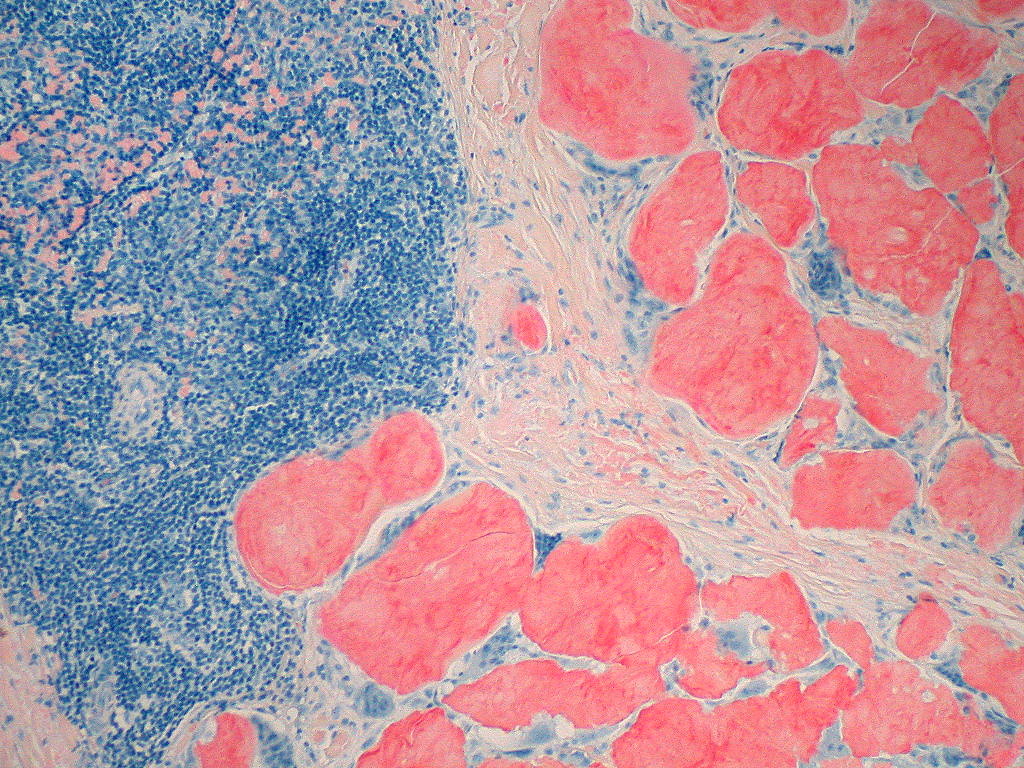
- diagnosis made by biopsy of affected tissue and positive Congo Red staining with red green birefringence under polarised light microscopy. Rectum or subcutaneous fat are relatively non-invasive site for biopsy
Primary amyloidosis (AL amyloidosis)
- in lymphoproliferative disorder (myeloma, MGUS, non-Hodgkin lymphoma), clonal plasma cells in bone marrow produce immunoglobulins that are amyloidogenic
- presents with nephrotic syndrome, cardiomyopathy (avoid digoxin), autonomic and sensory neuropathies, hepatomegaly, periorbital purpura and macroglossia
- echo : 'sparkling' appearance (restrictive cardiomyopathy)
Familial amyloidosis (transthyretin-associated)
- autosomal dominant
- renal disease less prevalent than AL amyloidosis and macroglossia does not occur
Reactive amyloidosis (AA amyloidosis)
- formed from serum amyloid A (SAA), which is an acute phase protein
- occurs in chronic inflammatory disorder
- presents with nephrotic syndrome, hepatomegaly and splenomegaly, cardiac involvement is much less common



Medullary sponge kidney
- prevalence 1:1000 to 1:5000
- congenital disorder of kidney characterised by cystic dilatation of collecting tubules in one or both kidneys
- cyst formation is commonly associated with development of small calculi within the cyst
- 20% have associated hypercalciuria or renal tubular acidosis
- diagnosis is made via excretion urography, showing small calculi within papillary zone with surrounding increased density

- congenital disorder of kidney characterised by cystic dilatation of collecting tubules in one or both kidneys
- cyst formation is commonly associated with development of small calculi within the cyst
- 20% have associated hypercalciuria or renal tubular acidosis
- diagnosis is made via excretion urography, showing small calculi within papillary zone with surrounding increased density

Methaemoglobinaemia
- caused by either genetic defect in red cell metabolism or haemoglobin structure or acquired by a variety of drugs and toxins
- results from oxidation of ferrous iron in haemoglobin to ferric form
- oxygen-hemoglobin dissociation curve shifts to left
- causing precipitation as Heinz bodies and eventually leads to hemolytic anemia
- common drugs: dapsone, nitrates, antimalarials, sulphonamides and dyes
- presents with cyanosis, SOB, mental status change, headache, dizziness, arrhythmias, seizures
- chocolate brown blood
- low SaO2 (on oximeter) but good PO2 (ABG)
- treatment: methylene blue 1-2mg/kg and oxygen, ascorbic acid as second line drug
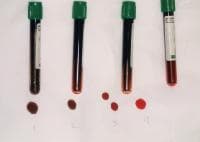
- results from oxidation of ferrous iron in haemoglobin to ferric form
- oxygen-hemoglobin dissociation curve shifts to left
- causing precipitation as Heinz bodies and eventually leads to hemolytic anemia
- common drugs: dapsone, nitrates, antimalarials, sulphonamides and dyes
- presents with cyanosis, SOB, mental status change, headache, dizziness, arrhythmias, seizures
- chocolate brown blood
- low SaO2 (on oximeter) but good PO2 (ABG)
- treatment: methylene blue 1-2mg/kg and oxygen, ascorbic acid as second line drug

Saturday, 26 November 2011
Juvenile idiopathic arthritis
- persistent oligoarthritis is the most common form of JIA (50-60%), four or fewer joints are affected (knees, ankles and wrist). Uveitis is common with positive ANA and seen in younger girls (peak at 3 years old)
- polyarticular JIA affects older girls. 2 forms - rheumatoid factor positive or negative
- Still's disease presents with high fever, evanescent pink maculopapular rash with arthralgia, arthritis, myalgia and generalised lymphadenopathy. Autoantibodies are negative
- enthesitis related arthritis usually affects teenage boys, causing asymmetrical lower limb arthritis associated with HLA-B27 and risk of iritis

- polyarticular JIA affects older girls. 2 forms - rheumatoid factor positive or negative
- Still's disease presents with high fever, evanescent pink maculopapular rash with arthralgia, arthritis, myalgia and generalised lymphadenopathy. Autoantibodies are negative
- enthesitis related arthritis usually affects teenage boys, causing asymmetrical lower limb arthritis associated with HLA-B27 and risk of iritis

Thursday, 24 November 2011
Wolfram syndrome
- DIDMOAD (diabetes insipidus, diabetes mellitus, optic atrophy, deafness)
- autosomal recessive
- mutation in transmembrane gene, WFS1
- autosomal recessive
- mutation in transmembrane gene, WFS1
Wednesday, 23 November 2011
Graft versus host disease
- common complication after stem cell or bone marrow transplantation
- donor cells against normal host organs
- Billingham criteria - 3 criteria must be met in order for GVHD to occur
i) immunocompetent graft is administered with viable and functional immune cells
ii) recipient is immunologically disparate - histo-incompatible
iii) recipient is immunocompromised, therefore cannot inactivate or destroy the transplanted cells
- can be divided into acute (within first 100 days post-transplantation) or chronic
- onset of acute GVHD is usually from day 16 - day 20 as donor marrow engrafts and the neutrophils count rises
- acute GVHD causes a skin rash (typically commencing on palms and soles), diarrhea and jaundice
- more common after unrelated donor transplantation
- initial treatment of acute GVHD is high dose methylprednisolone. If no response, consider antilymphocyte globulin
- donor cells against normal host organs
- Billingham criteria - 3 criteria must be met in order for GVHD to occur
i) immunocompetent graft is administered with viable and functional immune cells
ii) recipient is immunologically disparate - histo-incompatible
iii) recipient is immunocompromised, therefore cannot inactivate or destroy the transplanted cells
- can be divided into acute (within first 100 days post-transplantation) or chronic
- onset of acute GVHD is usually from day 16 - day 20 as donor marrow engrafts and the neutrophils count rises
- acute GVHD causes a skin rash (typically commencing on palms and soles), diarrhea and jaundice
- more common after unrelated donor transplantation
- initial treatment of acute GVHD is high dose methylprednisolone. If no response, consider antilymphocyte globulin
Friday, 18 November 2011
Primary biliary cirrhosis (PBC)
- interlobular bile ducts are damaged by chronic granulomatous inflammation causing progressive cholestasis, cirrhosis and portal hypertension
- 90% are women in age range 40-50 years
- serum AMA (anti-mitochondrial antibodies) subtype M2 in 95%
- associated with autoimmune disorders (Sjogren, scleroderma, thyroid disorder)
- pruritus is earliest symptom, preceding jaundice by a few years
- back pain can be prominent in advanced PBC due to osteomalacia from malabsorption or hepatic osteodystrophy. Osteoporosis is common.
- palmar xanthoma, tuberous xanthomas are seen
- raised ALP, increased serum cholesterol, raised IgM levels
- liver biopsy : granulomas surrounding bile ducts in early disease later progressing to cirrhosis
- treatment: ursodeoxycholic acid and replacement of vitamin A,D,E and K
- median survival overall is 7-10years, reduced to 2 years in presence of jaundice

- 90% are women in age range 40-50 years
- serum AMA (anti-mitochondrial antibodies) subtype M2 in 95%
- associated with autoimmune disorders (Sjogren, scleroderma, thyroid disorder)
- pruritus is earliest symptom, preceding jaundice by a few years
- back pain can be prominent in advanced PBC due to osteomalacia from malabsorption or hepatic osteodystrophy. Osteoporosis is common.
- palmar xanthoma, tuberous xanthomas are seen
- raised ALP, increased serum cholesterol, raised IgM levels
- liver biopsy : granulomas surrounding bile ducts in early disease later progressing to cirrhosis
- treatment: ursodeoxycholic acid and replacement of vitamin A,D,E and K
- median survival overall is 7-10years, reduced to 2 years in presence of jaundice

Kallman's syndrome
- isolated GnRH deficiency
- X-linked, resulting from mutation of KAL1 gene which encodes anosmin-1
- occurs in 1:10,000 males
- results form disordered migration of gonadotrophin releasing hormone (GnRH) producing neurones into hypothalamus
- associated with anosmia, cleft palate, colour blindness, obesity, hypogonadotrophic hypogonadism
- treatment: male - hCG or testosterone restore pubertal development and secondary sexual characteristic. pulsed GnRH restore fertility ; female - cyclic estrogen and progesterone

- X-linked, resulting from mutation of KAL1 gene which encodes anosmin-1
- occurs in 1:10,000 males
- results form disordered migration of gonadotrophin releasing hormone (GnRH) producing neurones into hypothalamus
- associated with anosmia, cleft palate, colour blindness, obesity, hypogonadotrophic hypogonadism
- treatment: male - hCG or testosterone restore pubertal development and secondary sexual characteristic. pulsed GnRH restore fertility ; female - cyclic estrogen and progesterone

Thursday, 17 November 2011
DMARDs side effects
Methotrexate
- marrow suppression, hepatic fibrosis, pneumonitis
Sulfasalazine
- leukopenia & thrombocytopenia, rash and macrocytosis
Hydroxychloroquine
- retinopathy
Gold
- given by IM
- pancytopenia, lung fibrosis, cholestatic jaundice, glomerulonephritis, angioneurotic edema, exfoliative dermatitis
Penicillamine
- drug-induced lupus, proteinuria, loss of taste, pancytopenia
Leflunomide
- diarrhea, nausea, alopecia, rash
Wednesday, 16 November 2011
Atrial myxoma
- most common primary cardiac tumor
- most cases are sporadic. 10% are familial (autosomal dominant)
- majority are solitary, usually develop in left atrium (75-85%) and are polypoid, gelatinous structures attached by a pedicle to atrial septum
- may obstruct mitral valve and can send showers of emboli
- constitutional symptoms in a third of cases
- signs: loud first heart sound, tumor 'plop' (loud third heart sound produced as pedunculated tumor comes to an abrupt halt), mid diastolic murmur and signs due to embolism
- raised ESR
- rarely, associated with adrenal hyperplasia, Leydig cell tumor and Carney complex

- most cases are sporadic. 10% are familial (autosomal dominant)
- majority are solitary, usually develop in left atrium (75-85%) and are polypoid, gelatinous structures attached by a pedicle to atrial septum
- may obstruct mitral valve and can send showers of emboli
- constitutional symptoms in a third of cases
- signs: loud first heart sound, tumor 'plop' (loud third heart sound produced as pedunculated tumor comes to an abrupt halt), mid diastolic murmur and signs due to embolism
- raised ESR
- rarely, associated with adrenal hyperplasia, Leydig cell tumor and Carney complex

CHRPE
- congenital hypertrophy of retinal pigment epithelium
- 'bear track' lesion
- can be typical or atypical
- typical: grey or black with depigmented lacunas and are found in one quadrant of one eye, do no affect vision
- atypical: white fishtail and bilateral. They do not affect vision but if they are more than 4 atypical CHRPE in each eye then FAP or Gardner syndrome might be suspected
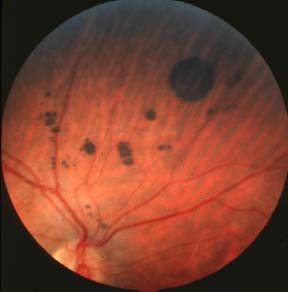
- 'bear track' lesion
- can be typical or atypical
- typical: grey or black with depigmented lacunas and are found in one quadrant of one eye, do no affect vision
- atypical: white fishtail and bilateral. They do not affect vision but if they are more than 4 atypical CHRPE in each eye then FAP or Gardner syndrome might be suspected

Dopamine dysregulation syndrome
- a.k.a hedonistic dysregulation
- dysfunction of reward system in Parkinson's disease due to long exposure to dopamine replacement therapy
- characterised by self control problems such as addiction to medication, hypersexuality or gambling
- patient typically increase the amount of dopamine agonist although it will worsen their dyskinesia
- management: L-dopa dosage reduction
- dysfunction of reward system in Parkinson's disease due to long exposure to dopamine replacement therapy
- characterised by self control problems such as addiction to medication, hypersexuality or gambling
- patient typically increase the amount of dopamine agonist although it will worsen their dyskinesia
- management: L-dopa dosage reduction
Coeliac disease
- a.k.a gluten sensitive enteropathy
- caused by an immunological reaction to gliadin fraction of wheat and other cereals
- 95% HLA DQ2 and HLA DQ8
- gliadin provokes an inflammatory response which results in partial or total villous atrophy in proximal small bowel
- presents with diarrhea, oral ulcer, weight loss, growth retardation, abdominal pain and anemia
- associated with dermatitis herpetiformis and IgA deficiency
- increased risk of all GI malignancy, especially small bowel lymphoma and esophageal CA
- diagnosis by IgA anti-endomysial antibodies
- duodenal/jejunal biopsy shows hypertrophied crypts of Lieberkuhn, villous atrophy, degenerated surface epithelial cells and increase in intraepithelial lymphocytes
- treatment:gluten free diet
- caused by an immunological reaction to gliadin fraction of wheat and other cereals
- 95% HLA DQ2 and HLA DQ8
- gliadin provokes an inflammatory response which results in partial or total villous atrophy in proximal small bowel
- presents with diarrhea, oral ulcer, weight loss, growth retardation, abdominal pain and anemia
- associated with dermatitis herpetiformis and IgA deficiency
- increased risk of all GI malignancy, especially small bowel lymphoma and esophageal CA
- diagnosis by IgA anti-endomysial antibodies
- duodenal/jejunal biopsy shows hypertrophied crypts of Lieberkuhn, villous atrophy, degenerated surface epithelial cells and increase in intraepithelial lymphocytes
- treatment:gluten free diet
Sunday, 13 November 2011
Hypertension with hypokalemia
Differential diagnosis
1) Renal artery stenosis / Renin secreting tumor (secondary hyperaldosteronism)
- high renin ; high aldosterone
2) Adrenal hyperfunction / Conn's syndrome (primary hyperaldosteronism)
- low renin ; high aldosterone
- adrenal adenoma are usually sensitive to ACTH, thus aldosterone secretion falls during the day as ACTH declines. With bilateral adrenal hyperplasia, aldosterone concentration is higher when patient is erect than supine.
3) Liddle's syndrome
4) Syndrome of apparent mineralocorticoid excess (SAME) / Liquorice usage
- low renin and low aldosterone
- SAME is an autosomal recessive disorder caused by mutation of HSD11B2 which encodes 11-B-hydroxysteroid dehydrogenase (which coverts cortisol to cortisone)
- Liquorice is a temporary form of AME due to its ability to block the enzyme

1) Renal artery stenosis / Renin secreting tumor (secondary hyperaldosteronism)
- high renin ; high aldosterone
2) Adrenal hyperfunction / Conn's syndrome (primary hyperaldosteronism)
- low renin ; high aldosterone
- adrenal adenoma are usually sensitive to ACTH, thus aldosterone secretion falls during the day as ACTH declines. With bilateral adrenal hyperplasia, aldosterone concentration is higher when patient is erect than supine.
3) Liddle's syndrome
4) Syndrome of apparent mineralocorticoid excess (SAME) / Liquorice usage
- low renin and low aldosterone
- SAME is an autosomal recessive disorder caused by mutation of HSD11B2 which encodes 11-B-hydroxysteroid dehydrogenase (which coverts cortisol to cortisone)
- Liquorice is a temporary form of AME due to its ability to block the enzyme

Marfan's syndrome
- autosomal dominant
- mutation in fibrillin gene (FBN-1) on chromosome 15 (15 alphabates in Marfan's syndrome)
- abnormal fibrillin-1 interfere with normal microfibril formation, results in defects in ligament of lens, as well as abnormalities in structural integrity of aortic wall, lens zonules, ligaments, lung airways and spinal dura
- clinical features: tall stature, ectopia lentis, MVP, aortic root dilatation, aortic dissection, scoliosis, high arched palate, pectus excavatum, upward and temporal lens dislocation (downward in homocystinuria)
- treatment: beta-blocker (slow rate of dilatation of aortic root), lifestyle alteration, yearly echocardiogram

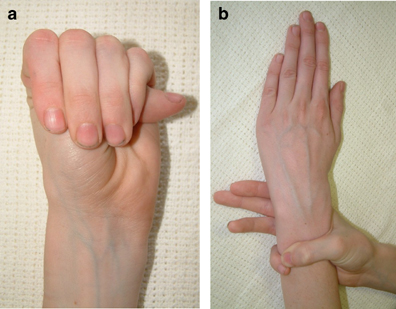
- mutation in fibrillin gene (FBN-1) on chromosome 15 (15 alphabates in Marfan's syndrome)
- abnormal fibrillin-1 interfere with normal microfibril formation, results in defects in ligament of lens, as well as abnormalities in structural integrity of aortic wall, lens zonules, ligaments, lung airways and spinal dura
- clinical features: tall stature, ectopia lentis, MVP, aortic root dilatation, aortic dissection, scoliosis, high arched palate, pectus excavatum, upward and temporal lens dislocation (downward in homocystinuria)
- treatment: beta-blocker (slow rate of dilatation of aortic root), lifestyle alteration, yearly echocardiogram


Echocardiography
M-mode
- details changing motion of structures along the ultrasound beam with time
- assess LV wall and cavity dimensions, pericardial thickness

2-dimensional echo
- assessment of ventricular volumes and ejection fraction; delineation of specific anatomy of cardiac structures including valves

Pulse doppler echocardiography
- assess diastolic function and dysfunction by assessing transmitral flow velocities, differentiate between constrictive and restrictive cardiomyopathy
Continuous wave doppler
- assess transvalvular pressure gradients, to estimate severity of stenotic lesions (which causes increased velocities)
Color doppler
- assess severity of valvular regurgitations
- details changing motion of structures along the ultrasound beam with time
- assess LV wall and cavity dimensions, pericardial thickness

2-dimensional echo
- assessment of ventricular volumes and ejection fraction; delineation of specific anatomy of cardiac structures including valves

Pulse doppler echocardiography
- assess diastolic function and dysfunction by assessing transmitral flow velocities, differentiate between constrictive and restrictive cardiomyopathy
Continuous wave doppler
- assess transvalvular pressure gradients, to estimate severity of stenotic lesions (which causes increased velocities)
Color doppler
- assess severity of valvular regurgitations
Saturday, 12 November 2011
Glucose transporter
GLUT-1 : basal non-insulin-stimulated glucose uptake into many cells
GLUT-2 : glucose sensing (glucose transport into beta cells)
GLUT-3 : non-insulin-mediated glucose uptake into brain neurones and placenta
GLUT-4 : channel through which glucose is taken up into muscle and adipose tissue cells following stimulation of insulin receptor (peripheral action of insulin)

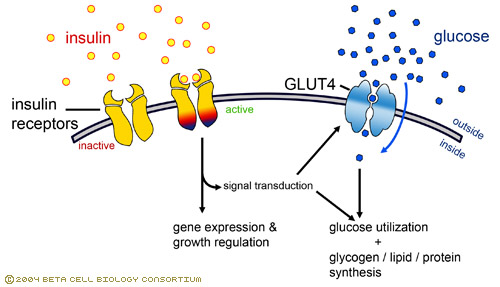
GLUT-2 : glucose sensing (glucose transport into beta cells)
GLUT-3 : non-insulin-mediated glucose uptake into brain neurones and placenta
GLUT-4 : channel through which glucose is taken up into muscle and adipose tissue cells following stimulation of insulin receptor (peripheral action of insulin)


Hairy cell leukemia
- rare leukemia, 2% of lymphoid leukemia
- male:female = 4:1
- hairy cells are larger than lymphocytes, their nuclei show a homogenous loose chromatic pattern without a visible nucleolus and cells have abundant cytoplasm with broad base projection or villi, nuclear outline is often kidney shape
- presents with pancytopenia and massive splenomegaly
- associated with monocytopenia (typical finding)
- skin vasculitis (erythema nodosum & cutaneous nodules) in one third of patients
- bone marrow trephine biopsy: characteristic clear zone between cell (fried egg appearance)
- increased bone marrow reticulin often results in dry tap marrow aspirate despite marrow hypercellularity
- abnormal cells are strongly positive for tartrate resistant acid phosphatase strain (TRAP)
- respond dramatically to purine analogues (cladribine and pentostatin), with survival rate at 5 years
of 95-95%

- male:female = 4:1
- hairy cells are larger than lymphocytes, their nuclei show a homogenous loose chromatic pattern without a visible nucleolus and cells have abundant cytoplasm with broad base projection or villi, nuclear outline is often kidney shape
- presents with pancytopenia and massive splenomegaly
- associated with monocytopenia (typical finding)
- skin vasculitis (erythema nodosum & cutaneous nodules) in one third of patients
- bone marrow trephine biopsy: characteristic clear zone between cell (fried egg appearance)
- increased bone marrow reticulin often results in dry tap marrow aspirate despite marrow hypercellularity
- abnormal cells are strongly positive for tartrate resistant acid phosphatase strain (TRAP)
- respond dramatically to purine analogues (cladribine and pentostatin), with survival rate at 5 years
of 95-95%

Apoptosis
- programmed cell death
- features: cell shrinkage, compaction of chromatin, nuclear blebbing, cell fragmentation, energy dependent process, phagocytosis
- functions: elimination of cells in embryological development, induction of tolerance to self antigen, removal of virally infected cells and cells with damaged DNA
- 2 pathways
i) Extrinsic: Fas-Fas ligand interaction leads to release of caspase 8 and then caspase 3 (executioner caspase) activating DNA cleavage by CAD (caspase-activatable DNAase)
ii)Intrinsic: cellular stress (eg:growth factor withdrawal or p53 cycle arrest) induces pro-apoptotic proteins (bax,bak). Cytochrome C binds Apaf1 (forming apoptosome) activates caspase 9
- Bax, Bad and Bak are members of oncogenes which promote cell death
- Bcl-2 inhibits apoptosis
- disease of excess and insufficient apoptosis
excess: neurodegeneration, HIV disease
insufficient: cancer, autoimmunity

- features: cell shrinkage, compaction of chromatin, nuclear blebbing, cell fragmentation, energy dependent process, phagocytosis
- functions: elimination of cells in embryological development, induction of tolerance to self antigen, removal of virally infected cells and cells with damaged DNA
- 2 pathways
i) Extrinsic: Fas-Fas ligand interaction leads to release of caspase 8 and then caspase 3 (executioner caspase) activating DNA cleavage by CAD (caspase-activatable DNAase)
ii)Intrinsic: cellular stress (eg:growth factor withdrawal or p53 cycle arrest) induces pro-apoptotic proteins (bax,bak). Cytochrome C binds Apaf1 (forming apoptosome) activates caspase 9
- Bax, Bad and Bak are members of oncogenes which promote cell death
- Bcl-2 inhibits apoptosis
- disease of excess and insufficient apoptosis
excess: neurodegeneration, HIV disease
insufficient: cancer, autoimmunity

Friday, 11 November 2011
Yellow nail syndrome

- disorder of lymphatic drainage
- thickened slow growing yellow nails
- associated with pleural effusion and lymphoedema of legs
- 40% also have bronchiectasis
Brugada syndrome
- first described in 1992
- more common in young male adults in South East Asia
- autosomal dominant
- approximately 20% of cases, the underlying cause is genetic defect in SCN5A gene, which encodes sodium channel controlling the depolarisation phase of cardiac action potential
- manifests with syncope and cardiac arrest, typically occurs in 3rd or 4th decade of life, usually at rest or during sleep
- ECG: ST elevation in leads V1 to V3 and RBBB (present spontaneously or provoked by ajmaline or flecainide)
- treatment: ICD
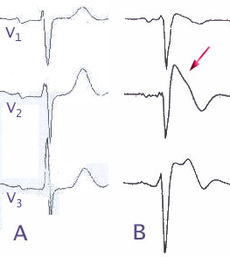
- more common in young male adults in South East Asia
- autosomal dominant
- approximately 20% of cases, the underlying cause is genetic defect in SCN5A gene, which encodes sodium channel controlling the depolarisation phase of cardiac action potential
- manifests with syncope and cardiac arrest, typically occurs in 3rd or 4th decade of life, usually at rest or during sleep
- ECG: ST elevation in leads V1 to V3 and RBBB (present spontaneously or provoked by ajmaline or flecainide)
- treatment: ICD

Statistic (2)
Type 1 (alpha) error

- null hypothesis is falsely rejected (false positive)
- equals significance level of a test
- equals significance level of a test
Type 2 (beta) error
- null hypothesis is falsely accepted (false negative)
Power of a test (power of a test to detect a difference)
= 1 - beta
= 1 - (type 2 error)
MALT lymphoma
- third most common type of non Hodgkin lymphoma (gastric B cell lymphoma)
- most commonly found in stomach
- associated with Helicobacter pylori infection
- treatment: H.pylori eradication, if failed, chemotherapy
- complications: paraprotein formation and pseudohyponatraemia
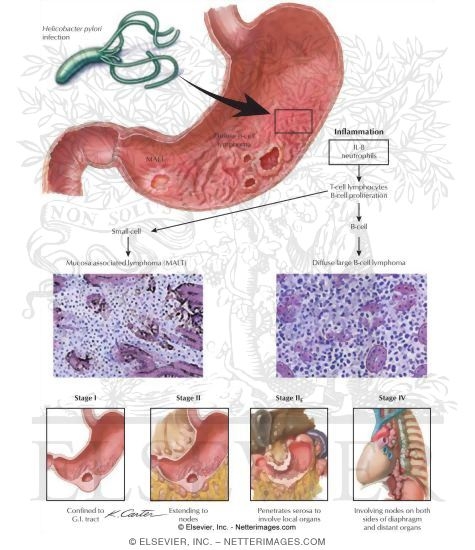
- most commonly found in stomach
- associated with Helicobacter pylori infection
- treatment: H.pylori eradication, if failed, chemotherapy
- complications: paraprotein formation and pseudohyponatraemia

Central limit theorem
- The random sampling distribution of any means would always tends to be normal, irrespective of the population distribution for which the sample were drawn. Hence, even if the population distribution is skewed or in any non normal distribution, the sample means would be normally distributed
- Mean of the random sampling distribution is equal to the mean of original population

- Mean of the random sampling distribution is equal to the mean of original population

Chronic granulomatous disease
- rare immunodeficiency due to a defect in neutrophil killing and characterised by deep seated infection
- defect in production of NADPH-oxidase found in phagocytes
- patients with CGD have defective phagocytes that are able to engulf bacteria, but once engulf unable to kill them, leads to granuloma and microabscesses in skin, liver and bone
- nitroblue tetrazolium test is a simple screening test of reducing power of phagocytes

- defect in production of NADPH-oxidase found in phagocytes
- patients with CGD have defective phagocytes that are able to engulf bacteria, but once engulf unable to kill them, leads to granuloma and microabscesses in skin, liver and bone
- nitroblue tetrazolium test is a simple screening test of reducing power of phagocytes

Immune reconstitution inflammatory syndrome (IRIS)
- occurs in people who have been profoundly immunosuppressed and begin on HAART
- as immune system recovers, patient able to mount inflammatory response to a range of pathogens
- exacerbation of symptoms with new or worsening of clinical signs
Examples
- unusual mass lesions or lymphadenopathy associated with mycobacteria
- deteriorating radiological apperance associated with TB
- inflammatory retinal lesions associated with cytomegalovirus
- deteriorating liver function in chronic hepatitis B carrier
- vigorous vesicular eruption with herpes zoster
- as immune system recovers, patient able to mount inflammatory response to a range of pathogens
- exacerbation of symptoms with new or worsening of clinical signs
Examples
- unusual mass lesions or lymphadenopathy associated with mycobacteria
- deteriorating radiological apperance associated with TB
- inflammatory retinal lesions associated with cytomegalovirus
- deteriorating liver function in chronic hepatitis B carrier
- vigorous vesicular eruption with herpes zoster
Wednesday, 9 November 2011
Diabetes insipidus
- presents with polyuria, nocturia and compensatory polydipsia
- high or high normal plasma osmolality with low urine osmolality ( low osmolality in primary polydipsia)
- high 24-hour urine volume
- failure of urinary concentration with fluid deprivation
- if fluid deprivation causing urine osmolality > 300mOsm/kg, it suggest primary polydipsia ;
if not, it is either nephrogenic or cranial diabetes insipidus
Nephrogenic DI
- renal tubules are resistant to normal or high levels of plasma vasopressin
- causes : drugs (lithium, demeclocycline, glibenclamide), hypercalcemia, sickle cell disease, hypokalemia
- treatment: amiloride
Cranial DI
- causes: hypothalamic-pituitary surgery, Wolfram syndrome, meningitis, craniopharyngioma
- treatment: synthetic vasopressin analogue desmopressin (intranasal, oral or IM)

- high or high normal plasma osmolality with low urine osmolality ( low osmolality in primary polydipsia)
- high 24-hour urine volume
- failure of urinary concentration with fluid deprivation
- if fluid deprivation causing urine osmolality > 300mOsm/kg, it suggest primary polydipsia ;
if not, it is either nephrogenic or cranial diabetes insipidus
Nephrogenic DI
- renal tubules are resistant to normal or high levels of plasma vasopressin
- causes : drugs (lithium, demeclocycline, glibenclamide), hypercalcemia, sickle cell disease, hypokalemia
- treatment: amiloride
Cranial DI
- causes: hypothalamic-pituitary surgery, Wolfram syndrome, meningitis, craniopharyngioma
- treatment: synthetic vasopressin analogue desmopressin (intranasal, oral or IM)

Chancroid
- caused by Haemophilus ducreyi
- painful ulcer with necrotic base and ragged edge
- ulcer commonly on prepuce and frenulum in men; vaginal entrance and perineum in women
- inguinal lymphadenopathy that can progress to large buboes which suppurate
- diagnosis by isolating organism from swab taken from lesion and culture on chocolate based media
- treatment: azithromycin 1g orally or ceftriaxone 250mg IM or ciprofloxacin 500mg bd for 3 days

- painful ulcer with necrotic base and ragged edge
- ulcer commonly on prepuce and frenulum in men; vaginal entrance and perineum in women
- inguinal lymphadenopathy that can progress to large buboes which suppurate
- diagnosis by isolating organism from swab taken from lesion and culture on chocolate based media
- treatment: azithromycin 1g orally or ceftriaxone 250mg IM or ciprofloxacin 500mg bd for 3 days

Gaucher's disease
- deficiency in glucocerebrosidase
- results in accumulation of glucosylceramide in lysosomes of the reticuloendothelial system
- most common mutation is single base change causing substitution of arginine for serine
- characteristic pigmentation on exposed parts (forehand and hands), hepatosplenomegaly, pathological fracture
- diagnosis by finding a deficiency of lysosomal B glucocerebrosidase in leucocytes
- 3 types
Type 1 (non-neuropathic) - commonest
Type 2 (acute infantile neuropathic)
Type 3 (chronic neuropathic)
- high ALP, ACE and Ig levels
- raised acid phosphatase
- definitive diagnosis made by genetic testing
- treatment: enzyme replacement treatment

- results in accumulation of glucosylceramide in lysosomes of the reticuloendothelial system
- most common mutation is single base change causing substitution of arginine for serine
- characteristic pigmentation on exposed parts (forehand and hands), hepatosplenomegaly, pathological fracture
- diagnosis by finding a deficiency of lysosomal B glucocerebrosidase in leucocytes
- 3 types
Type 1 (non-neuropathic) - commonest
Type 2 (acute infantile neuropathic)
Type 3 (chronic neuropathic)
- high ALP, ACE and Ig levels
- raised acid phosphatase
- definitive diagnosis made by genetic testing
- treatment: enzyme replacement treatment

Congenital hyperbilirubinaemias
Unconjugated
- Gilbert's syndrome
- Criggler-Najjar syndrome
Conjugated
- Dubin-Johnson syndrome
- Rotor's syndrome
Gilbert's syndrome
- most common familial hyperbilirubinemia, 2-7% of population
- hepatic glucuronidation is 30% of normal
- reduced levels of UDP-glucuronosyl transferase (UGT-1) activity
- raised unconjugated bilirubin on fasting, and during mild illness
- bilirubin levels are reduced by enzyme inducer (eg: phenobarbitone)
- absence of bilirubin in urine(unconjugated bilirubin is tightly bound to albumin, thus cannot cross the glomerulus)
Criggler-Najjar syndrome
- very rare
- type II (autosomal dominant) - decreased UDP-GT
- type I (autosomal recessive) - absence of UDP-GT
Dubin-Johnson syndrome (autosomal recessive) & Rotor's syndrome (autosomal dominant)
- due to defects in bilirubin handling in liver
- good prognosis
- liver is black owing to melanin deposition
- Gilbert's syndrome
- Criggler-Najjar syndrome
Conjugated
- Dubin-Johnson syndrome
- Rotor's syndrome
Gilbert's syndrome
- most common familial hyperbilirubinemia, 2-7% of population
- hepatic glucuronidation is 30% of normal
- reduced levels of UDP-glucuronosyl transferase (UGT-1) activity
- raised unconjugated bilirubin on fasting, and during mild illness
- bilirubin levels are reduced by enzyme inducer (eg: phenobarbitone)
- absence of bilirubin in urine(unconjugated bilirubin is tightly bound to albumin, thus cannot cross the glomerulus)
Criggler-Najjar syndrome
- very rare
- type II (autosomal dominant) - decreased UDP-GT
- type I (autosomal recessive) - absence of UDP-GT
Dubin-Johnson syndrome (autosomal recessive) & Rotor's syndrome (autosomal dominant)
- due to defects in bilirubin handling in liver
- good prognosis
- liver is black owing to melanin deposition
Narcolepsy
- narcoleptic attacks are periods of irresistible sleep
- strongly associated with HLA-DR2 and HLA-DQB1*0602 antigen
- caused by loss of hypothalamic neuropeptide orexin. Orexins are released from synaptic terminals during wakefulness and increase the activity of brain regions associated with wakefulness.
- characterised by excessive daytime somnolence associated with cataplexy, hypnogogic or hypnopompic hallucination and sleep paralysis (classic tetrad)
- multiple sleep latency test EEG during the day shows rapid onset of REM sleep (less than 10 minutes after onset of sleep)
- treatment: non-pharmacological (sleep timetable, reduce alcohol intake); CNS stimulants (methylphenidate, amphetamine), modafinil
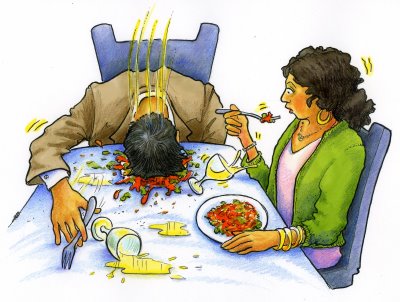
- strongly associated with HLA-DR2 and HLA-DQB1*0602 antigen
- caused by loss of hypothalamic neuropeptide orexin. Orexins are released from synaptic terminals during wakefulness and increase the activity of brain regions associated with wakefulness.
- characterised by excessive daytime somnolence associated with cataplexy, hypnogogic or hypnopompic hallucination and sleep paralysis (classic tetrad)
- multiple sleep latency test EEG during the day shows rapid onset of REM sleep (less than 10 minutes after onset of sleep)
- treatment: non-pharmacological (sleep timetable, reduce alcohol intake); CNS stimulants (methylphenidate, amphetamine), modafinil

Sunday, 6 November 2011
congenital long QT syndrome
- 2 major syndromes
Jervell and Lange-Nielsen syndrome (associated with deafness) - autosomal recessive
Romano Ward syndrome - autosomal dominant
- mutations in cardiac potassium and sodium channel genes
- 3 major subtypes
LQT1: provoked by exercise (LQT1 most common) - slow delayed rectifier potassium channel mutation
LQT2: provoked by emotion and acoustic stimuli (eg: door bell or telephone ring)
LQT3: at rest or when asleep
- presents with syncope and palpitations or sudden death
- management : beta blocker (reduce adrenergic demand and reduce sympathetic activation from left stellate ganglion). Avoid drugs that prolong QT interval
Jervell and Lange-Nielsen syndrome (associated with deafness) - autosomal recessive
Romano Ward syndrome - autosomal dominant
- mutations in cardiac potassium and sodium channel genes
- 3 major subtypes
LQT1: provoked by exercise (LQT1 most common) - slow delayed rectifier potassium channel mutation
LQT2: provoked by emotion and acoustic stimuli (eg: door bell or telephone ring)
LQT3: at rest or when asleep
- presents with syncope and palpitations or sudden death
- management : beta blocker (reduce adrenergic demand and reduce sympathetic activation from left stellate ganglion). Avoid drugs that prolong QT interval
Familial hypercholesterolemia
- autosomal dominant (mutation on short arm of chromosome 19)
- heterozygote 1:500; homozygote 1:1 million
- mutations in LDL receptor or Apo B
- tendon xanthomata is hallmark of the disease
- elevated LDL, with normal Tg
- premature cardiovascular disease
- treatment: statins

- heterozygote 1:500; homozygote 1:1 million
- mutations in LDL receptor or Apo B
- tendon xanthomata is hallmark of the disease
- elevated LDL, with normal Tg
- premature cardiovascular disease
- treatment: statins

Nephronophthisis
- autosomal recessive, deveops early in childhood
- thought to be due to dysfunction of cilia
- interstitial inflammation and tubular atrophy with later development of medullary cysts
- dominant features are polyuria, polydipsia and growth retardation

- thought to be due to dysfunction of cilia
- interstitial inflammation and tubular atrophy with later development of medullary cysts
- dominant features are polyuria, polydipsia and growth retardation

Diabetic amyotrophy
- a.k.a proximal diabetic neuropathy
- usually seen in older men with diabetes
- presents with painful wasting, usually asymmetrical of quadriceps muscles
- wasting may be very marked and knee reflexes are diminished
- affected area is often extremely tender
- nerve conduction studies to rule out other conditions
- 50% recover fully in 3-4 months
- often resolves in time with careful diabetic control or transference to insulin therapy

- usually seen in older men with diabetes
- presents with painful wasting, usually asymmetrical of quadriceps muscles
- wasting may be very marked and knee reflexes are diminished
- affected area is often extremely tender
- nerve conduction studies to rule out other conditions
- 50% recover fully in 3-4 months
- often resolves in time with careful diabetic control or transference to insulin therapy

Maturity onset diabetes of young (MODY)
- monogenic diabetes mellitus
- early onset of diabetes with strong family history, often easy to control
- autosomal dominant
- MODY 3 (mutation of HNF-1a) is the commonest (70%), sensitive to treatment with sulphonylureas, raised HDL, preserved insulin sensitivity and glycosuria
- MODY 2 (mutation in glucokinase), usually asymptomatic and does not need treatment, but important to identify as it can lead to reduced birthweight in pregnancy
- MODY 1 (mutation of HNF-4a), presents later in life
- MODY 5 (mutation of HNF-1b), leads to renal cyst and proteinuria
- MODY 4 (IPF-1 mutation) and MODY 6 (NeuroD1 mutation) are rare
*HNF = hepatic nuclear factor
IPF = insulin promoter factor

- early onset of diabetes with strong family history, often easy to control
- autosomal dominant
- MODY 3 (mutation of HNF-1a) is the commonest (70%), sensitive to treatment with sulphonylureas, raised HDL, preserved insulin sensitivity and glycosuria
- MODY 2 (mutation in glucokinase), usually asymptomatic and does not need treatment, but important to identify as it can lead to reduced birthweight in pregnancy
- MODY 1 (mutation of HNF-4a), presents later in life
- MODY 5 (mutation of HNF-1b), leads to renal cyst and proteinuria
- MODY 4 (IPF-1 mutation) and MODY 6 (NeuroD1 mutation) are rare
*HNF = hepatic nuclear factor
IPF = insulin promoter factor

Cryoglobulinemia
- cryoglobulins are immunoglobulins and complement components which precipitate reversibly in cold, which leads to small vessel damage and deposition on the wall of small vessel result in generalised vasculitis
- presents with purpura, arthralgia, leg ulcers, Raynaud's phenomenon, polyneuropathy, asymptomatic proteinuria, microscopic hematuria or nephrotic syndrome
- skin most commonly involved (>90%) - reticulated skin pattern of microthrombosis and areas of gangrene
- management : plasma exchange, high dose steroid, chemotherapy (cyclophosphamide) and treatment of underlying conditions
- 3 types are recognised
Type I
- monoclonal antibody (usually IgM)
- associated with multiple myeloma and lymphoproliferative disorder
- presents with acrocyanosis, Raynaud's phenomenon, retinal hemorrhage
Type II & III (mixed cryoglobulinemia)
- IgM or IgA with rheumatoid factor activity binds to polyclonal IgG
- type II is monoclonal ; whereas type III is polyclonal
- presents with glomerulonephritis (more common in type II), vasculitic rash and Raynaud's
- they can activate the classical pathway of complement and cause consumption therefore low C4 with normal C3
- associations: Hepatitis B and C, HIV, CMV, malaria, EBV, malaria, autoimmune disorder
* Meltzer's triad = Purpura + Arthralgia + Myalgia *
(Typically seen in polyclonal CG - hepatitis C)
- presents with purpura, arthralgia, leg ulcers, Raynaud's phenomenon, polyneuropathy, asymptomatic proteinuria, microscopic hematuria or nephrotic syndrome
- skin most commonly involved (>90%) - reticulated skin pattern of microthrombosis and areas of gangrene
- management : plasma exchange, high dose steroid, chemotherapy (cyclophosphamide) and treatment of underlying conditions
- 3 types are recognised
Type I
- monoclonal antibody (usually IgM)
- associated with multiple myeloma and lymphoproliferative disorder
- presents with acrocyanosis, Raynaud's phenomenon, retinal hemorrhage
Type II & III (mixed cryoglobulinemia)
- IgM or IgA with rheumatoid factor activity binds to polyclonal IgG
- type II is monoclonal ; whereas type III is polyclonal
- presents with glomerulonephritis (more common in type II), vasculitic rash and Raynaud's
- they can activate the classical pathway of complement and cause consumption therefore low C4 with normal C3
- associations: Hepatitis B and C, HIV, CMV, malaria, EBV, malaria, autoimmune disorder
* Meltzer's triad = Purpura + Arthralgia + Myalgia *
(Typically seen in polyclonal CG - hepatitis C)
Pityriasis rosea
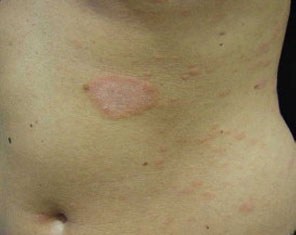

- self limiting rash commonly seen in adolescent or young adults
- thought to be viral or post-viral rash. Not caused by fungus
- begins as large single pink patch on trunk (Herald patch) followed by generalised body rash lasting for 6 weeks.
- No treatment is required. 1% menthol in aqueous cream may relieve any itch
Saturday, 5 November 2011
Lead poisoning
- occurs occupationally, pica, lead containing cosmetics or drugs
- presents with lethargy, abdominal pain, vomiting, constipation and encephalopathy
- typically results in peripheral motor neuropathy
- bluish discoloration of gum margins (deposition of lead sulphide) - Burton line
- basophilic stippling (due to aggregate of RNA in immature red cells owing to inhibition of pyrimidine-5-nucleotidase)
- investigation : blood lead level
- cause proximal RTA / Fanconi syndrome
- treatment: chelation with IV sodium calcium edetate or oral DMSA


- presents with lethargy, abdominal pain, vomiting, constipation and encephalopathy
- typically results in peripheral motor neuropathy
- bluish discoloration of gum margins (deposition of lead sulphide) - Burton line
- basophilic stippling (due to aggregate of RNA in immature red cells owing to inhibition of pyrimidine-5-nucleotidase)
- investigation : blood lead level
- cause proximal RTA / Fanconi syndrome
- treatment: chelation with IV sodium calcium edetate or oral DMSA


Suicide risk
SADPERSONS
S - sex
A - age
D - depression
P - previous attempt
E - ethanol abuse
R - rational thinking loss
S - social support lacking
O - organised plans
N - no spouse
S - sickness
S - sex
A - age
D - depression
P - previous attempt
E - ethanol abuse
R - rational thinking loss
S - social support lacking
O - organised plans
N - no spouse
S - sickness
Creutzfeldt Jakob disease (CJD)
- human prion disease
- prions are glycoproteins which codes for a membrane protein
- definitive diagnosis is post mortem neuropathological examination
- tonsillar biopsy and CSF 14-3-3 (marker of rapid neuronal destruction) helps in diagnosis
New variant CJD
- young adults (mean age 29) presents with painful sensory symptoms, psychiatric symptoms, ataxia, dementia, myoclonus, upgaze paresis and chorea
- MRI : high signal on T2 weighted image in pulvinar (posterior thalamus)
- EEG normal

Sporadic CJD
- older age, shorter disease duration
- rapidly progressive dementia, cerebellar ataxia, pyramidal and extrapyramidal signs and myoclonus
- EEG : triphasic waves
- prions are glycoproteins which codes for a membrane protein
- definitive diagnosis is post mortem neuropathological examination
- tonsillar biopsy and CSF 14-3-3 (marker of rapid neuronal destruction) helps in diagnosis
New variant CJD
- young adults (mean age 29) presents with painful sensory symptoms, psychiatric symptoms, ataxia, dementia, myoclonus, upgaze paresis and chorea
- MRI : high signal on T2 weighted image in pulvinar (posterior thalamus)
- EEG normal

Sporadic CJD
- older age, shorter disease duration
- rapidly progressive dementia, cerebellar ataxia, pyramidal and extrapyramidal signs and myoclonus
- EEG : triphasic waves
Friday, 4 November 2011
Cutaneous larva migrans
- caused by larvae of hookworm Ancylostoma braziliense which penetrate skin
- serpiginous, itchy rash
- treatment: 15% solution of topical tiabendazole

- serpiginous, itchy rash
- treatment: 15% solution of topical tiabendazole

Granuloma inguinale
- a.k.a donovanosis
- caused by Klebsiella granulomatis, encapsulated gram negative bacillus
- mode of transmission: sexual contact
- characteristic heaped up ulcerating lesion with prolific red granulation tissue
- rarely painful
- extension of primary infection to inguinal regions produces pseudo-bubo
- donovan bodies can be identified intracellularly in scrapings or biopsies of an ulcer
- treatment: doxycycline, bactrim or azithromycin

- caused by Klebsiella granulomatis, encapsulated gram negative bacillus
- mode of transmission: sexual contact
- characteristic heaped up ulcerating lesion with prolific red granulation tissue
- rarely painful
- extension of primary infection to inguinal regions produces pseudo-bubo
- donovan bodies can be identified intracellularly in scrapings or biopsies of an ulcer
- treatment: doxycycline, bactrim or azithromycin

Thursday, 3 November 2011
Minerals deficiency
Zinc deficiency
- acrodermatitis enteropathica is an inherited disorder caused by malabsorption of zinc
- causes dermatitis, growth retardation, severe diarrhea, alopecia, poor wound healing and impaired taste and smell
Selenium deficiency
- rare, except in Keshan (Chine) where soil has low selenium conteny
- causes cardiomyopathy
Copper deficiency
- Menkes' kinky hair syndrome is caused by malabsorption of copper
- causes anemia, growth failure, mental retardation, brittle hair
- acrodermatitis enteropathica is an inherited disorder caused by malabsorption of zinc
- causes dermatitis, growth retardation, severe diarrhea, alopecia, poor wound healing and impaired taste and smell
Selenium deficiency
- rare, except in Keshan (Chine) where soil has low selenium conteny
- causes cardiomyopathy
Copper deficiency
- Menkes' kinky hair syndrome is caused by malabsorption of copper
- causes anemia, growth failure, mental retardation, brittle hair
Heparin induced thrombocytopenia
- usually occurs 5-14 days after first heparin exposure
- due to immune response directed against heparin/platelet factor 4 complexes
- paradoxially associated with severe thrombosis (most commonly DVT)
- thrombosis results from IgG-induced platelet activation (via platelet Fc receptor) which leads to generation of procoagulant, platelet derived microparticles.
- Type 1 HIT (non-immune) presents with first 2 days after exposure, platelet count normalised with continued heparin therapy (rarely falls below 100 X 10^9/L in type 1). Type 2 HIT (immune mediated) is the serious type with thrombotic complications.
- presence of anti-PF4-heparin antibodies
- alternative anticoagulation: heparinoid danaparoid or direct thrombin inhibitor hirudin
(avoid warfarin - risk of warfarin necrosis)

- due to immune response directed against heparin/platelet factor 4 complexes
- paradoxially associated with severe thrombosis (most commonly DVT)
- thrombosis results from IgG-induced platelet activation (via platelet Fc receptor) which leads to generation of procoagulant, platelet derived microparticles.
- Type 1 HIT (non-immune) presents with first 2 days after exposure, platelet count normalised with continued heparin therapy (rarely falls below 100 X 10^9/L in type 1). Type 2 HIT (immune mediated) is the serious type with thrombotic complications.
- presence of anti-PF4-heparin antibodies
- alternative anticoagulation: heparinoid danaparoid or direct thrombin inhibitor hirudin
(avoid warfarin - risk of warfarin necrosis)

Ciclosporin

- calcineurin inhibitor
- inhibit calcium dependent second messenger signals in T cells following activation via TCR
- inhibits IL-2 production by T-lymphocytes
- adverse effects (4HRT)
H - hyperkalemia, hypertension, hypertrichosis, hypertrophy of gum
R - renal toxicity (chronic interstitial nephritis)
T - tremor
Glucagonoma

- rare alpha cell tumor
- 90% associated with skin rash (necrolytic migratory erythema)
- 70% are malignant, metastasis are common at presentation
- treatment: combination chemotherapy (streptazocin and 5-FU)
Morphoea

- localised scleroderma characterised by firm, white, violaceous patch of skin which usually occurs on thigh, trunk or arms
- begins as erythematous or flesh-colored plaques that become sclerotic, develop central hypopigmentation and demonstrate an erythematous border
- localised morphea (one or a few lesions); generalised morphea (widespread cutaneous lesion without systemic involvement)
- physical therapy to prevent joint contracture and to maintain function
- usually resistant to therapy
Pyoderma gangrenosum
- erythematous nodules or pustules which frequently ulcerate
- typical bluish black undermined edge and a purulent surface
- biopsy: intense neutrophilic infiltrate
- causes: inflammatory bowel disease (UC > Crohn's) , RA, myeloma, leukemia, lymphoma, PBC
- treatment: potent topical steroid, tacrolimus ointment
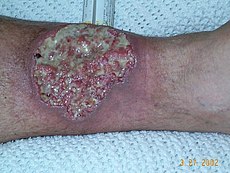
- typical bluish black undermined edge and a purulent surface
- biopsy: intense neutrophilic infiltrate
- causes: inflammatory bowel disease (UC > Crohn's) , RA, myeloma, leukemia, lymphoma, PBC
- treatment: potent topical steroid, tacrolimus ointment

Lichen planus
- pruritic inflammatory dermatosis commonly associated with mucosal involvement
- associated with autoimmune diseases
- rash is characterised by small, purple flat-topped, polygonal papules that are intensely pruritic
- common on flexor of wrist and lower legs
- genitalia can be affected
- fine lacy white pattern on surface of lesion (Wickham's striae)
- exhibit Koebner phenomenon
- treatment: topical steroid or topical tacrolimus ointment for painful mucosa disease
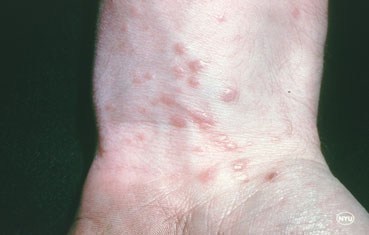

- associated with autoimmune diseases
- rash is characterised by small, purple flat-topped, polygonal papules that are intensely pruritic
- common on flexor of wrist and lower legs
- genitalia can be affected
- fine lacy white pattern on surface of lesion (Wickham's striae)
- exhibit Koebner phenomenon
- treatment: topical steroid or topical tacrolimus ointment for painful mucosa disease


Diphtheria
- caused by Corynebacterium diphtheriae (Gram positive bacillus)
- produces a toxin which affects myocardium, nervous and adrenal tissues
- most common presentation is with pharyngitis
- areas of grey or white fibrinous exudate coalesce to produce a tough grey-yellow membrane that bleeds when removed (pseudomembrane)
- regional lymphadenopathy produces "bull-neck"
- cutaneous diphtheria may occur, typically ulcer is punched-out with undermined edges covered with a greyish white to brownish adherent membrane
- neuritis frequently follows bulbar distribution
- treatment: anti-toxin (risk of anaphylaxis) and benzylpenicillin 1.2gm QID for 1 week


- produces a toxin which affects myocardium, nervous and adrenal tissues
- most common presentation is with pharyngitis
- areas of grey or white fibrinous exudate coalesce to produce a tough grey-yellow membrane that bleeds when removed (pseudomembrane)
- regional lymphadenopathy produces "bull-neck"
- cutaneous diphtheria may occur, typically ulcer is punched-out with undermined edges covered with a greyish white to brownish adherent membrane
- neuritis frequently follows bulbar distribution
- treatment: anti-toxin (risk of anaphylaxis) and benzylpenicillin 1.2gm QID for 1 week


Wednesday, 2 November 2011
Erythroderma
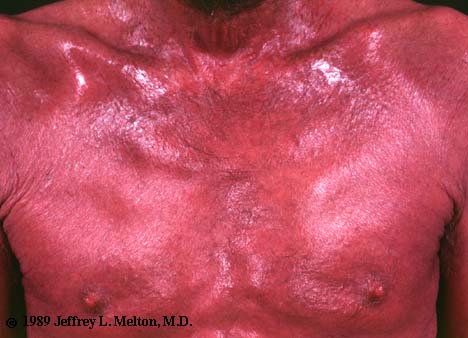
- inflammatory skin disease with erythema and scaling that affects nearly entire cutaneous surface
- a.k.a exfoliative dermatitis
- most commonly due to eczema, followed by psoriasis, lymphoma/leukemia, drug (sulphonamide, gold, penicillin, allopurinol)
- complications: hypothermia, fluid loss, capillary leak syndrome, high output cardiac failure
- treatment: emollients and fluid replacement, oral methotraxate for erythrodermic psoriasis
Subscribe to:
Comments (Atom)